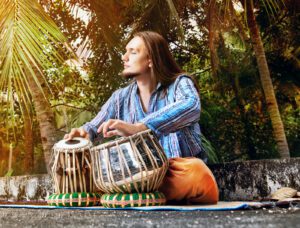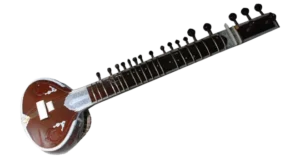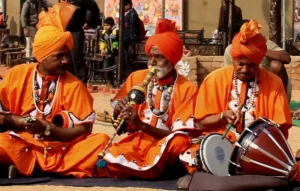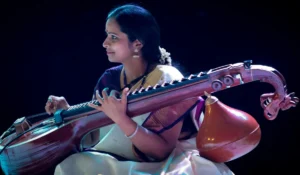Indian Music
in Indian art and culture
Indian music is a rich tapestry that captures the subcontinent’s varied cultures, customs, and histories. It can be roughly divided into two primary categories: North Indian Hindustani music and South Indian Carnatic music. Hindustani music is distinguished by its use of ragas, which are melodic frameworks that evoke particular emotions, and by its improvisational style.
Carnatic music, on the other hand, frequently has complex rhythms and focuses more of an emphasis on compositions and lyrical content. India is home to a wide variety of folk and popular music genres, such as Bollywood soundtracks, ghazals, and bhangra, which combine traditional and modern elements, in addition to classical music in Indian art and culture
.
Key components of these musical genres, which highlight the nation’s distinctive soundscapes, are instruments like the harmonium, tabla, and sitar. Music is the soul of any culture and there has been a tradition of music in India, Narad Muni Rishi launched the art of music on earth. A flute with seven holes has been recovered from the Indus Valley Civilization.
Other tools the origin of Ravanhatha is derived from the Hela civilization of Sri Lanka. Raga Khad Sato Sanvara has been found in descending order in Samaveda. Some parts of Veena are mentioned in Aitareya Aranyaka. Gemini Brahmin talks about dance and music. Musicologists have propounded the source theory of all ragas and savors from the word Om.
Indian music spans many different genres and styles, creating a diverse tapestry of sounds. It falls into two general categories: folk music, which is regionally specific, and classical music, which includes Hindustani and Carnatic traditions.
In live performances, instruments such as the harmonium, tabla, and sitar are essential. Indian music places a lot of emphasis on improvisation and frequently combines complex rhythms and melodies. Bollywood in particular has contributed to the global popularization of Indian music by fusing traditional and modern elements.
This rich musical legacy promotes harmony among India’s citizens while also reflecting the country’s cultural diversity.
History of Indian Music in Indian art and culture
The greatest development of Indian music has been influenced by the Indian music played at Bhagati venues, a sequence that was demonstrated in the late Vedic period through a type of Indian music called Kantiya Sangeet Sangam which involved the chanting of verses.
Which was made to suit the musical melodies. Which was made to suit the musical melodies. And its 22 keys discussed in detail. These 22 keys have been identified as shrutis, the distinction is also made in the Dantiilma supporting the existence of 22 shrutis towards them, in which it is invoked that only these can be made by the human body.

Sarang Dev, who wrote the book Sangeet Ratnakara, supported this view. Another important text of this period is the Samvarmela Kalanithi written by Ramamatya or Ramamatya in the sixteenth century. Chaturderdi Prakashi of Venkatamakkhini in the 17th century is also famous for Carnatika music lore.
During the ancient and early medieval periods, we got such Gurukuls. We find evidence of the existence of Gurukuls where students lived with the teacher to make them proficient in the art of music. We find evidence of the existence of Gurukuls where students lived with the teacher to make them proficient in the art of music. The students had to stay in the 12th Ras Ashram and gain knowledge while serving the Guru.

The ashrams were patronized by kings and wealthy men of society, life in the ashram was filled with knowledge through rigorous contemplation, contemplation and direct experience, all students, whether prince or common man, were treated equally, no one discriminated against.
This entry of Islamic and Persian elements changed the face of North Indian music, for example, the devotional style of singing preserved by the mother-in-law was transformed into the 15th century dhrupad style. By the 17th century, the new form of singing had developed into Indian music, it is called the khyal style, in addition, more and more styles of folk singing began to emerge.
It is necessary to understand the anatomy of Indian classical music, the three main pillars of Indian classical Indian music, the samvara, raga and the rhythm, these elements can be known as. In ancient times, the vowel words have also been divided into the Vedas to define the scale degree.

The current is linked to the text of the Sasaver text from the link on the sa, re, ga, ma, pa, dha, ni.At present, the symbolic system of Hindustani music is defined by these seven abridged and pure swaras pa, ni, Only the varas are audible from the smallest 22 shruti representing the quality of a shruti Awasthi. These 12 have seven pure vows and five vikirt swaras ga, ma, pa, dha, or ni.
these seven swaras are called sapta ya Sargam. Raga Sabad Sanskriti Samved comes from Ranja, which has statutory means to please or please the person. Ragas form the basis of melodious songs while rhythms form the basis of rhythms. Each melodic structure of a raga evokes emotions about a different personality. The basic element of the operation of colors is the vow on which it is based.

There are three main castes according to the number of svaras in ash. odov here is Pancha voar raga It consists of five servers. Sandov raga is 6 swara raga It consists of six servers.
The entire raga is saptasamvara raga. It has 7 savers. The raga has neither scale nor mode, it’s strange, ascending and descending Katiya and scientific, precise, subtle and aesthetic melodious and melodious in it, it has five or six series of complete self.
There are three major types of ragas
Pure melody
Pure raga is a raga in which its nature does not change if any Svar which is not present is sung.
Chhayalag raga
It is a raga in which if any of the svaras that is present in the original composition is sung, its nature and form changes.
Narrow melody
This is a raga that has two or more Rago combinations, so each raga should have five basic Svara.
conclusion
Indian music is a profound expression of the country’s heritage because of its rich diversity and deep cultural roots in Indian art and culture. It captures the complexity of Indian society by fusing vibrant folk and modern genres with classical traditions like Hindustani and Carnatic.
People from all areas and backgrounds come together through music in Indian art and culture, which not only keeps them entertained but also promotes a sense of community. Indian music’s evolution, shaped by both contemporary inventions and historical occurrences, demonstrates its adaptability and relevance in the modern world.
In the end, Indian music is a timeless art form that appeals to listeners both domestically and internationally.
